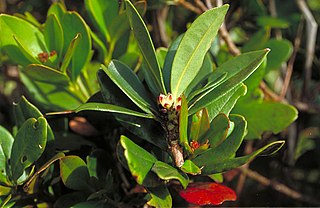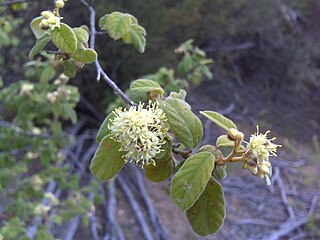
Flindersia australis, commonly known as crow's ash, flindosy or Australian teak, is a species of tree that is endemic to north-eastern Australia. It has pinnate leaves with between five and thirteen egg-shaped to elliptical leaflets, white to cream-coloured flowers arranged in panicles on the ends of branchlets and followed by woody capsules studded with short, rough points and containing winged seeds.

Acronychia suberosa, commonly known as corky acronychia, is a species of small to medium-sized rainforest tree that is endemic to eastern Australia. It has mostly trifoliate leaves with elliptic to egg-shaped leaflets with the narrower end towards the base, small groups of cream-coloured flowers and elliptical to spherical, creamy yellow to whitish fruit.

Medicosma cunninghamii, commonly known as pinkheart or bonewood, is a species of shrub or small tree in the family Rutaceae and is endemic to eastern Australia. It has simple, narrow oblong to lance-shaped leaves and small white or cream-coloured flowers arranged in small groups.

Boronia forsteri is a plant in the citrus family Rutaceae and is endemic to mountain ranges in central Queensland, Australia. It is an erect shrub with many branches, simple leaves with a densely hairy, pale underside, and pink, four-petalled flowers.

Leptospermum sericatum is a species of erect shrub that is endemic to Queensland. It has thin, firm bark, narrow egg-shaped to elliptical leaves, white or pink flowers arranged usually singly on side shoots and fruit that falls from the plant when the seeds are released.

Flindersia brassii, commonly known as hard scented maple or Claudie River scented maple, is a species of tree that is endemic to Queensland. It has pinnate leaves with between four and nine narrow elliptical leaflets, white or cream-coloured flowers arranged in panicles, and fruit studded with rough points.

Flindersia dissosperma, commonly known as scrub leopardwood, is a species of small tree in the family Rutaceae and is endemic to eastern-central Queensland. It usually has pinnate leaves with between three and five elliptical to egg-shaped leaves, panicles of white to cream-coloured flowers and fruit studded with rough points.
Medicosma elliptica, commonly known as Bulburin medicosma, is a species of shrub or small tree in the family Rutaceae and is endemic to a restricted area of Queensland. It has elliptical leaves and white flowers borne singly or in small groups in leaf axils.

Medicosma fareana, commonly known as white aspen, is a species of rainforest small tree in the family Rutaceae and is endemic to north Queensland. It has elliptical leaves and white or cream-coloured flowers borne singly or in small groups in leaf axils.

Medicosma glandulosa is a species of shrub or small tree in the family Rutaceae and is endemic to far north Queensland. It has elliptical to egg-shaped leaves and flowers that are white with red tips or cream-coloured, borne singly or in small groups in leaf axils.
Medicosma heterophylla is a species of small tree in the family Rutaceae and is endemic to a restricted area of far north Queensland. It has simple and trifoliate, elliptical leaves and leaflets, and cream-coloured to pink or reddish flowers borne singly or in small groups in leaf axils.
Medicosma mulgraveana is a species of small tree in the family Rutaceae and is endemic to a restricted area of far north Queensland. It has mostly trifoliate leaves with elliptical to egg-shaped leaflets and white flowers borne in small groups in leaf axils.
Medicosma obovata is a species of shrub or small tree in the family Rutaceae and is endemic to a restricted area of far north Queensland. It has simple egg-shaped leaves with the narrower end towards the base and white flowers borne singly or in small groups in leaf axils.

Medicosma sessiliflora is a species of shrub or small tree in the family Rutaceae and is endemic to far north Queensland. It has simple elliptical to egg-shaped leaves with the narrower end towards the base and cream-coloured flowers borne singly or in small groups in leaf axils.
Philotheca glasshousiensis is a species of flowering plant in the family Rutaceae and is endemic to Queensland. It is a shrub with densely glandular-warty branchlets, lance-shaped to wedge-shaped leaves clustered near the ends of the branchlets and cream-coloured flowers arranged singly or in groups of up to five.

Philotheca queenslandica is a species of flowering plant in the family Rutaceae and is endemic to south-eastern Queensland. It is a wiry shrub with elliptic to egg-shaped leaves with the narrower end toward the base and densely crowded near the ends of the glandular-warty branchlets, and cream-coloured flowers tinged with pink and arranged singly in leaf axils.
Goodenia atriplexifolia is a species of flowering plant in the family Goodeniaceae and is endemic to Queensland. It is a woody sub-shrub covered with woolly hairs, with elliptic to egg-shaped leaves with toothed or serrated edges, and leafy spikes of cream-coloured flowers.

Pultenaea dargilensis is a species of flowering plant in the family Fabaceae and is endemic to a small area in central Victoria, Australia. It is a leaning or low-lying shrub with narrow elliptic to lance-shaped leaves and yellow flowers usually arranged singly on the ends of branchlets.
Bursaria calcicola is a species of flowering plant in the family Pittosporaceae and is endemic to a restricted area near Wombeyan Caves in New South Wales. It is a spiny, hairy, erect or sprawling shrub with clustered, narrowly elliptic to egg-shaped leaves, white flowers with triangular sepals, cream-coloured petals and flattened fruit.

Pomaderris subcapitata is a species of flowering plant in the family Rhamnaceae and is endemic to south-eastern continental Australia. It is a shrub with hairy stems, elliptic to egg-shaped leaves and dense clusters of cream-coloured or yellow flowers.













